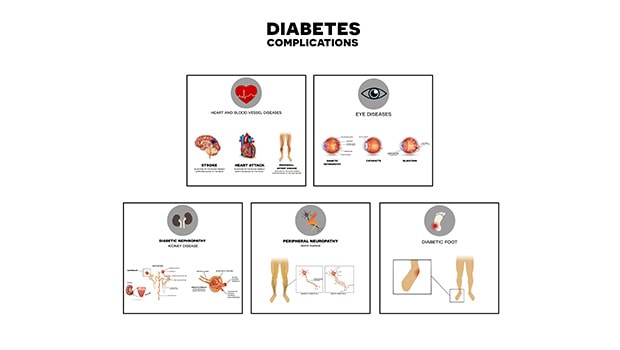Diabetes Complications – What You Need to Know

Integrated Diabetes Services (IDS) provides detailed advice and coaching on diabetes management from certified diabetes educators and dieticians. Insulin Nation and Type 2 Nation hosts a regular Q&A column from IDS that answers questions submitted from the diabetes community.
Q – I’ve recently been diagnosed with diabetes and I’m scared of complications. What are the most common, what are the warning signs, and how do I treat them?
A – Not everyone with diabetes will have diabetes complications. While it’s not easy to think about complications, not thinking about them is an ineffective prevention strategy. It’s important to understand what the common complications are and how to prevent them.
These complications occur when the body is damaged by chronically uncontrolled blood sugar, blood pressure, or cholesterol levels, or some combo of the three. The good news is that complications can often be prevented, limited, or effectively treated. Diabetes complications are less common now than before because potential problems are being detected earlier; there are also are more treatment options available than before.
There are two types of diabetes complications – acute and chronic. Acute complications are those that pose an immediate risk and could occur at any time through the course of life with diabetes. These acute complications are hypoglycemia (dangerously low blood sugar levels) and diabetic ketoacidosis (dangerously high blood sugar levels that lead to ketones in the blood).
We’re going to focus in this column on chronic complications that typically appear after several years of elevated and uncontrolled blood sugars. These include:
Cardiovascular disease (heart disease, stroke, and peripheral vascular disease)
-Men and women with diabetes are at increased risk for heart disease compared to those without diabetes
-Risk factors include age, high blood pressure, high cholesterol, tobacco use, and family history
– Prevention and treatment methods can include cholesterol control, smoking cessation, blood sugar control, regular exercise, and aspirin
Eye disease (retinopathy, cataracts, glaucoma)
-People with diabetes are 25 times more likely to have eye disease and become blind than those without diabetes
-Retinopathy is damage to the lining of the inside of the eye. Mild retinopathy may be asymptomatic, but serious retinopathy may start with symptoms of blurred vision, black spots in vision, or some blindness. Surgery is a treatment option
-Cataracts can start with blurred or cloudy vision. Treatment includes surgery and lens implants
-Glaucoma is increased pressure in the eyes. Common symptoms are headache, nausea, vomiting, eye pain, blurred vision, and watery eyes.Treatment includes eye drops, laser therapy, and surgery
-For prevention, visit an ophthalmologist at least once a year, maintain tight control of blood sugar, and control blood pressure
Neuropathy (nerve damage in hands, feet, stomach, and skin)
-Develops due to long-term high blood sugar levels
-There are two types of neuropathy – autonomic and peripheral
-Autonomic neuropathy affects the cardiovascular system, digestive system, skin and genitourinary systems. Symptoms include low blood pressure, dizziness, nausea, fullness after meals, bloating, sexual dysfunction, inability to empty bladder fully, cracked skin, and impaired wound healing
-Peripheral neuropathy affects sensation, especially in feet and legs. Risk to damage is high due to loss of sensation and wounds or cuts going unnoticed. Symptoms include burning, tingling, pain, or numbness in the extremities
-There are a variety of treatment options for both forms of neuropathy, but the most important include blood sugar and blood pressure control, self-examination for wounds, and seeking medical help for all wounds
Kidney Disease (nephropathy)
-Damage to the kidneys is caused by long-term high blood sugar as well as high blood pressure
-Early detection can reduce the risk of progression
-Symptoms include nausea, swelling in the ankles, puffiness around the eyes, increased blood pressure, muscle cramps, and persistent fatigue or shortness of breath
-Prevention includes yearly screenings, blood sugar and blood pressure control, medication, self-monitoring of kidney function, and diet adjustments
While not every diabetes complication can be avoided by every person with diabetes, many can be avoided with self-examination, regular medical screenings, blood sugar control, and blood pressure control.
Submit your questions to jennifer@integrateddiabetes.com. All questions will be answered, and yours may be chosen to appear on Insulin Nation or Type 2 Nation.
Integrated Diabetes Services provides one-on-one education and glucose regulation for people who use insulin. Diabetes “coaching” services are available in-person and remotely via phone and online for children and adults. Integrated Diabetes Services offers specialized services for insulin pump and continuous glucose monitor users, athletes, pregnancy & Type 1 diabetes, and those with Type 2 diabetes who require insulin. For more information, call 1-610-642-6055, or write info@integrateddiabetes.com.